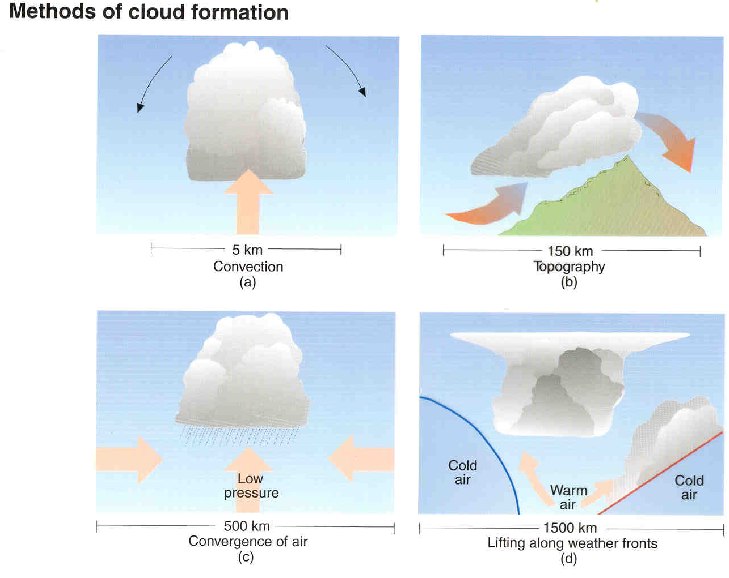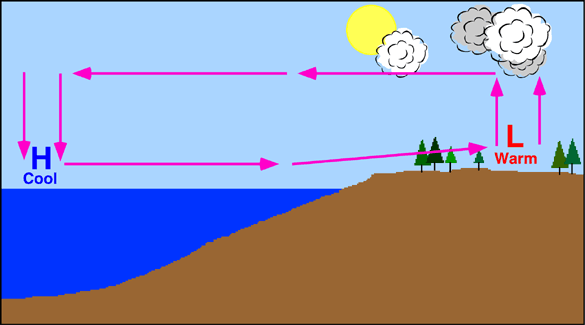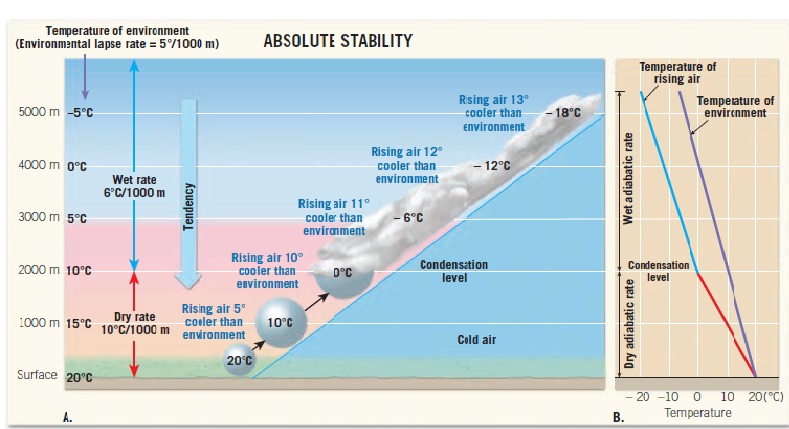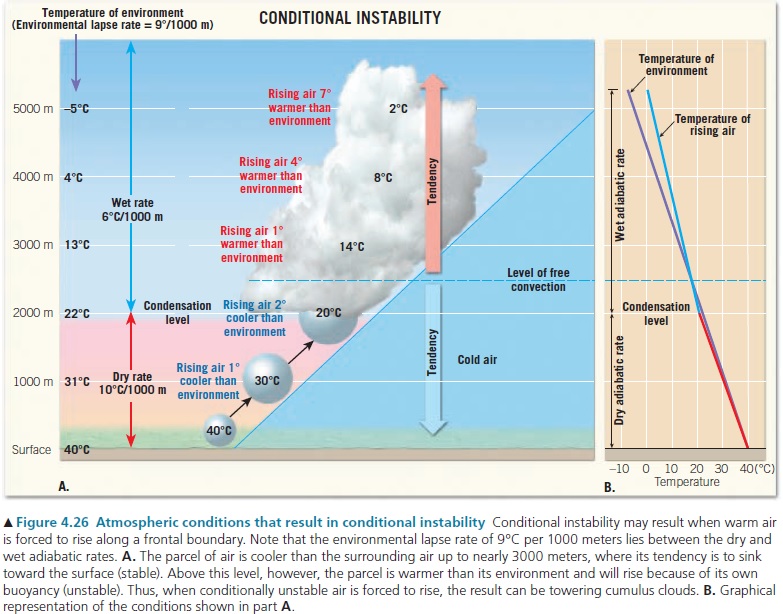Chapter 4--
Moisture and Atmospheric Stability
https://richhoffmanclass.com/test2review.html IT HAS EVERYTHING YOU NEED TO GET AN A ON THE EXAM.
TEST 2 OCTOBER 20TH --- on chapters 3 - 4 and 5 ---- Test 2 is OCTOBER 20TH
REMEMBER THIS EXAM IS MORE DIFFICULT THAN EXAM 1
VIDEOS FOR CHAPTER 4
The unending circulation of Earth's water supply is called the
hydrologic cycle (or water cycle). The cycle illustrates the continuous movement
of water from the oceans to the atmosphere, from the atmosphere to the land,
and from the land back to the sea. The quantitative view of the hydrologic
cycle is referred to as the water balance.
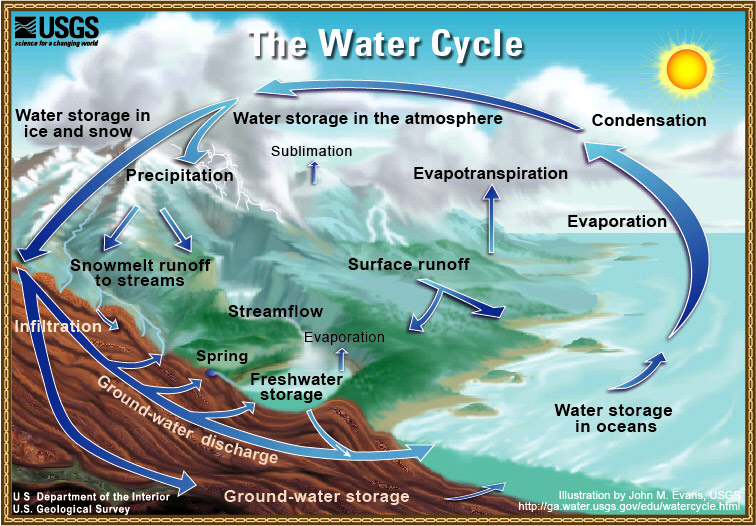
Water vapor, an odorless, colorless gas, can change from one state of matter (solid, liquid, or gas) to another at the temperatures and pressures experienced on Earth.
The heat energy involved in the change of state of water is
often measured in calories. The processes that change the state of matter
of water include evaporation (liquid to gas), condensation (gas to liquid),
melting (solid to liquid), freezing (liquid to solid), sublimation (solid
to gas), and deposition (gas to solid). During each change, latent (hidden
or stored) heat energy is either absorbed or released.
Pages 85 - 87 States of Water *********very important.......
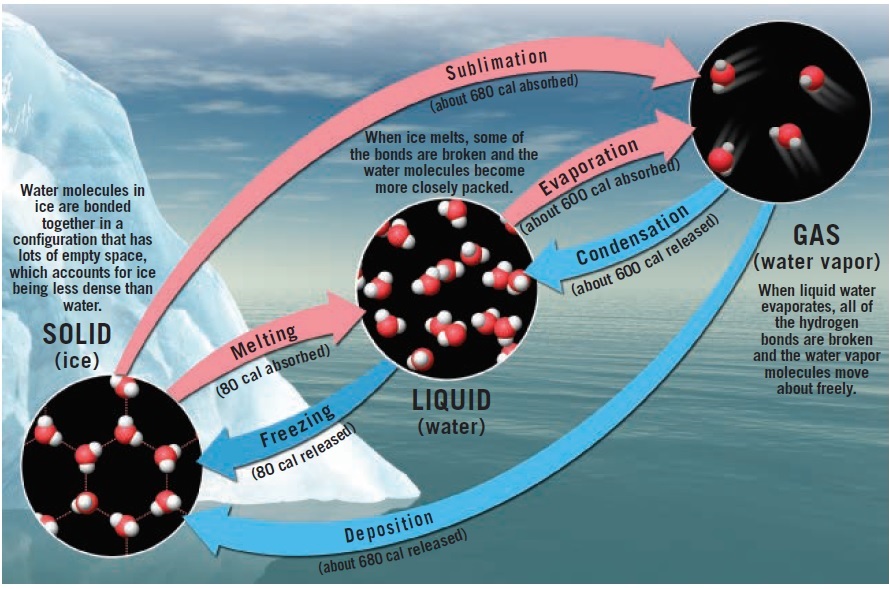

When water changes state, heat is exchanged between water and its surroundings.
When water evaporates, heat is absorbed. When water condenses, heat is released.
This heat is measured by calories. One calorie is the amount of heat required
to raise the temperature of 1 gram of water 1C.Because the Heat is used to
melt ice does not produce a temperature change, its referred to as latent
heat. Latent heat means hidden. It takes 80 calories
to melt one gram of ice. It takes about 540 to 600 calories to go from gas
to liquid. To go from Gas to Solid (deposition) heat released 680 calories.
Humidity is the general term used to describe the amount of water vapor in the air. The methods used to express humidity quantitatively include (1) absolute humidity, the mass of water vapor in a given volume of air, (2) mixing ratio, the mass of water vapor in a unit mass of dry air, (3) vapor pressure, that part of the total atmospheric pressure attributable to its water vapor content, (4) relative humidity, the ratio, most often expressed as percent, of the air's actual water vapor content compared with the amount of water vapor required for saturation at that temperature, and (5) dew point, the temperature to which a parcel of air would need to be cooled to reach saturation. When air is saturated, the pressure exerted by the water vapor, called the saturation vapor pressure, produces a balance between the number of water molecules leaving the surface of the water and the number returning. Because the saturation vapor pressure is temperature-dependent, at higher temperatures more water vapor is required for saturation to occur.
Relative humidity can be changed in two ways,
(1) by changing the amount of moisture in the air, or
(2) by changing the air's temperature.
Relative Humidity is a ratio of the air's actual water-vapor content compared with the amount of water vapor required for saturation at that temperature.
Adding moisture to the air while keeping the temperature constant
increases the relative humidity. Removing moisture lowers the relative humidity.
When the water vapor content of air remains at a constant level, a decrease
in air temperature results in an increase in relative humidity and an increase
in temperature causes a decrease in relative humidity. In nature, there are
three major ways that air temperatures change to cause corresponding changes
in relative humidity;
(1) daily (daylight versus nighttime) changes in temperature,
(2) temperature changes that result as air moves horizontally from one location
to another
(3) changes caused as air moves vertically in the atmosphere.
An important concept related to relative humidity is the dew-point
temperature (or simply dew point), which is the temperature to which a parcel
of air would need to be cooled to reach saturation.
Unlike relative humidity, which is a measure of how near
the air is to being saturated, dew-point temperature is a measure of the air's
actual moisture content.
High dew-point temperatures equate to moist air and low dew-point
temperatures indicate dry air. Because the dew-point temperature is a good
measure of the amount of water vapor in the air, it is
the measure of atmospheric moisture that appears on daily weather maps.
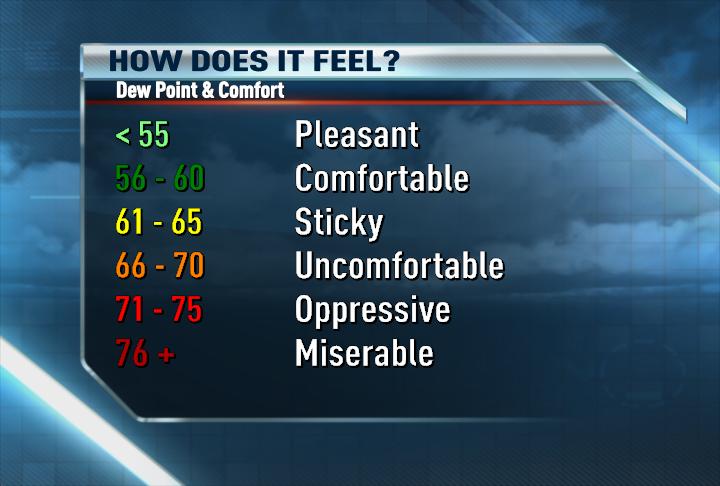
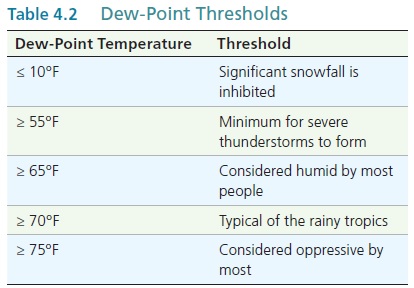
A variety of instruments, called hygrometers, can be used to measure relative humidity. One of the simplest hygrometers, a psychrometer, consists of two identical thermometers mounted side by side. One thermometer, called the wet bulb thermometer, has a thin muslin wick tied around the bulb. After spinning or fanning air past the instrument and noting the difference between the dry- and wet-bulb readings (known as the depression of the wet bulb), tables are consulted to determine the relative humidity. A second instrument, the hair hygrometer, can be read directly without using tables.
When air is allowed to expand, it cools. When air is compressed,
it warms. Temperature changes produced in this manner, in which heat is neither
added nor subtracted, are called adiabatic temperature changes. The rate of
cooling or warming of vertically moving unsaturated ("dry") air
is 10°C for every 1000 meters (5.5°F per 1000 feet), the dry adiabatic
rate. At the lifting condensation level (the altitude where the parcel of
air has reached saturation and cloud formation begins), latent heat is released
and the rate of cooling is reduced. The slower rate of cooling, called the
wet adiabatic rate of cooling ("wet" because the air is saturated)
varies from 5°C per 1000 meters for air with a high moisture content to
9°C per 1000 meters for air with a low moisture content.
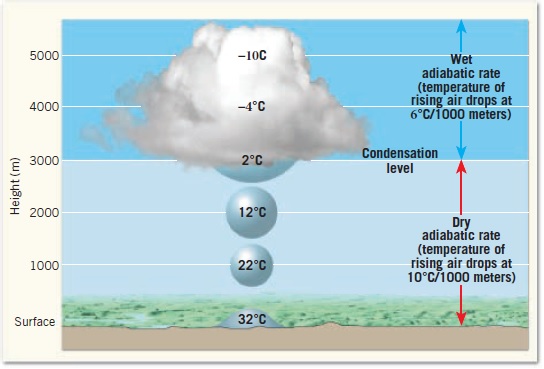
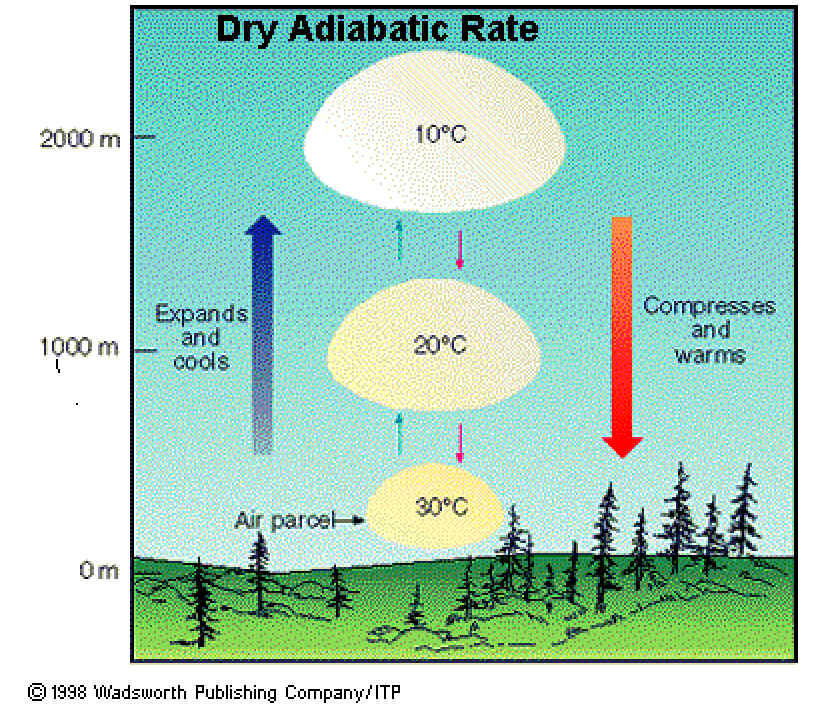
When air rises, it expands and cools adiabatically. If air is
lifted sufficiently high, it will eventually cool to its dew-point temperature,
and clouds will develop. Condensation occurs when water vapor
is cooled enough to change to a liquid.
When air expands it cools and when air is compressed it warms..
Very important. The temperature change in which heat was niether added or
subtracted is called adiabatic temperature changes.
***************************
Dry Adiabatic rate-Unsaturated air cools at a constant rate of 10C for every 1000 meters of asecent. (5.5F for 1000 feet).
Wet Adiabatic rate - Saturated air cools from 5C to 9C per 1000 meters.
This class will use 6C per 1000 meters for Wet Adiabatic rate
The altitude at which a parcel reaches saturation and cloud formation begins
is called the lifting condensation level ( LCL). Level of Clouds
Four mechanisms that cause air to rise are PAGES 97 -100
(1) orographic lifting, where air is forced to rise over a
mountainous barrier,
(2) frontal wedging, where warmer, less dense air is forced over cooler, denser
air along a front,
(3) convergence, a pileup of horizontal air flow resulting in an upward flow,
and
(4) localized convective lifting, where unequal surface heating causes localized
pockets of air to rise because of their buoyancy.
When air rises, it cools and can eventually produce clouds.
Stable air resists vertical movement, whereas unstable air rises. The stability
of air is determined by knowing the environmental lapse rate, the temperature
at various heights. The environmental lapse rate is the actual temperature
of the atmosphere, as determined from observations made by radiosondes and
aircraft. Adiabatic temperature
changes are charges in temperature that a parcel of air would experience if
moved vertically through the atmpsphere.
**********The three fundamental conditions of the atmosphere are******* important....
(1) absolute stability, when the environmental lapse rate is less than the
wet adiabatic rate,
(2) absolute instability(UNSTABLE), when the environmental lapse rate
is greater than the dry adiabatic rate,
(3) conditional instability(UNSTABLE), when moist air has an environmental
lapse rate between the dry and wet adiabatic rates.
The temperature decrease in the troposphere, the bottom layer
in which we live, is called the environmental lapse rate. Its average value
is 6.5°C per kilometer,(3.5/3.6 F per 1000 feet) a figure known as the
normal lapse rate. IN THIS CLASS, WE WILL BE USING A LOT OF MEASUREMENTS WITH METERS. 1000 METERS = 1 KILOMETER. The environmental lapse rate is not a constant and
must be regularly measured using radiosondes.
VERY VERY VERY IMPORTANT -- READ PAGE 96 TO 105..
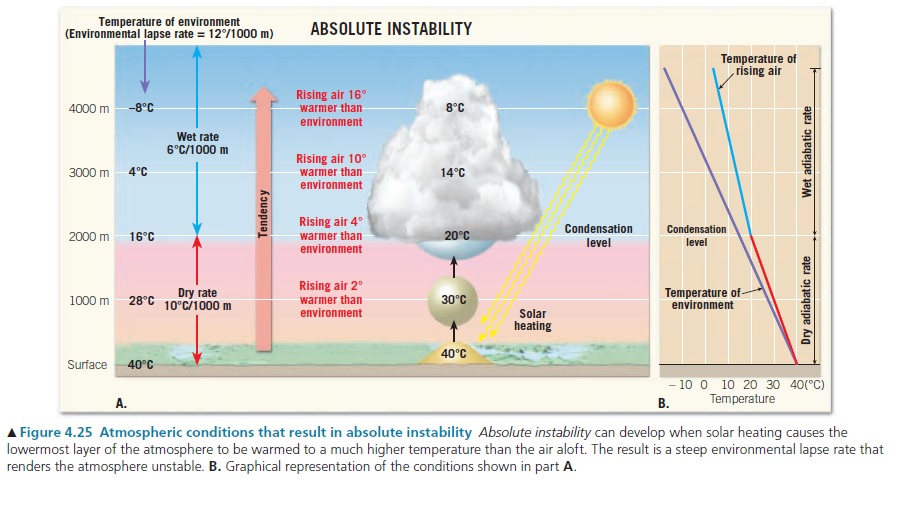
PLEASE WATCH THE BELOW VIDEOS--- UNDERSTAND HOW AIR RISIES AND SINKS. Air cools and Expands as it rises and Warms and Compresses as it sinks,
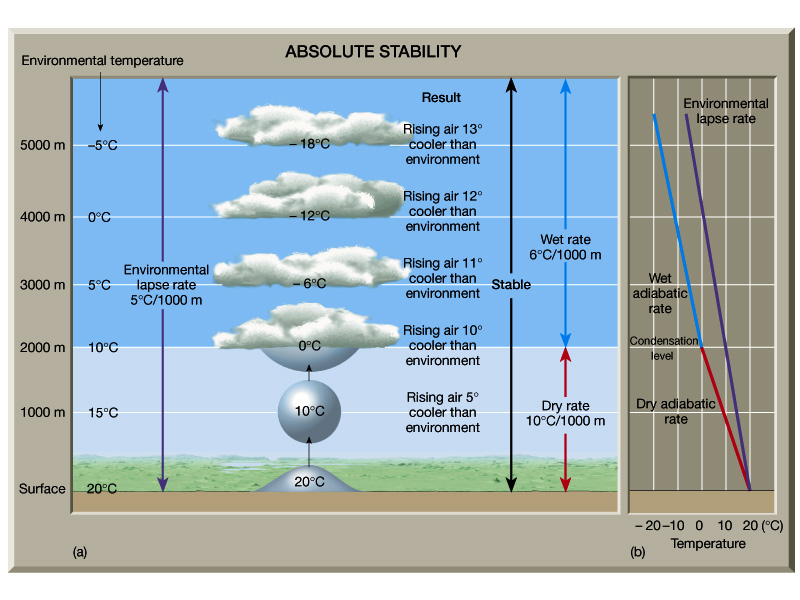 |
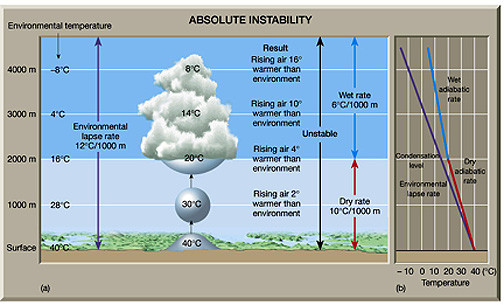 |
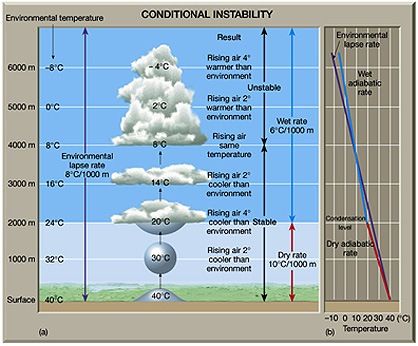 |
Example: IMPORTANT**********READ BELOW.........
Lapse rate 5C, Dry =10C Wet 6C = Absolute Stability
Lapse rate 12C, Dry =10C Wet 6C = Absolute InStability (UNSTABLE)
Lapse rate 9C, Dry =10C Wet 6C = Conditional InStability(UNSTABLE)
If the environmental lapse rate is less than the Wet Lapse Rate - the state of the air/atmospshere is STABLE
If the
environmental lapse rate is greater than the Dry Lapse Rate - the state of the air/atmosphere is UNSTABLE
If the Air Parcel is WARMER than the Environment - the atmosphere at that level is UNSTABLE.
If the Air Parcel is COLDER than the Environment - the atmosphere at that level is STABLE
PAGES 100-106 VERY IMPORTANT - figures 4.24, 4.25 and 4.26 ***** PAGES 102-103 FOR FIGURES********
In general, when stable air is forced aloft, the associated clouds have little vertical thickness, and precipitation, if any, is light. In contrast, clouds associated with unstable air are towering and frequently accompanied by heavy rain.
SKEW-T
Parameters
Types
of Soundings -- SEVERE WEATHER SOUNDING PARAMETERS
SKEW-T Details
Upper Air Details
OKX
Sounding
SPC
Mesoscale Analysis Pages
Current
Soundings
Sounding
indices - what do the numbers on a sounding mean
More about soundings - http://www.theweatherprediction.com/
Any factor that causes air near the surface to become warmed in relation to the air aloft increases the air's stability. The opposite is also true; any factor that causes the surface air to be chilled results in the air becoming more stable. Most processes that alter stability result from temperature changes caused by horizontal or vertical air movement, although daily temperature changes are important too. Changes in stability occur as air moves horizontally over a surface having a markedly different temperature than the air. Furthermore, subsidence (a general downward airflow) generally stabilizes the air, while upward air movement enhances instability.
TTEST 2 OCTOBER 20TH --- on chapters 3 - 4 and 5 ---- Test 2 is OCTOBER 20TH
